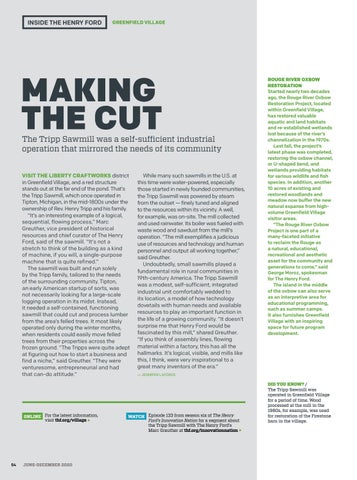INSIDE THE HENRY FORD
GREENFIELD VILLAGE
MAKING THE CUT
The Tripp Sawmill was a self-sufficient industrial operation that mirrored the needs of its community VISIT THE LIBERTY CRAFTWORKS district in Greenfield Village, and a red structure stands out at the far end of the pond. That’s the Tripp Sawmill, which once operated in Tipton, Michigan, in the mid-1800s under the ownership of Rev. Henry Tripp and his family. “It’s an interesting example of a logical, sequential, flowing process,” Marc Greuther, vice president of historical resources and chief curator of The Henry Ford, said of the sawmill. “It’s not a stretch to think of the building as a kind of machine, if you will, a single-purpose machine that is quite refined.” The sawmill was built and run solely by the Tripp family, tailored to the needs of the surrounding community. Tipton, an early American startup of sorts, was not necessarily looking for a large-scale logging operation in its midst. Instead, it needed a self-contained, functioning sawmill that could cut and process lumber from the area’s felled trees. It most likely operated only during the winter months, when residents could easily move felled trees from their properties across the frozen ground. “The Tripps were quite adept at figuring out how to start a business and find a niche,” said Greuther. “They were venturesome, entrepreneurial and had that can-do attitude.”
ONLINE For the latest information, visit thf.org/villagec
54
JUNE-DECEMBER 2020
While many such sawmills in the U.S. at this time were water-powered, especially those started in newly founded communities, the Tripp Sawmill was powered by steam from the outset — finely tuned and aligned to the resources within its vicinity. A well, for example, was on-site. The mill collected and used rainwater. Its boiler was fueled with waste wood and sawdust from the mill’s operation. “The mill exemplifies a judicious use of resources and technology and human personnel and output all working together,” said Greuther. Undoubtedly, small sawmills played a fundamental role in rural communities in 19th-century America. The Tripp Sawmill was a modest, self-sufficient, integrated industrial unit comfortably wedded to its location, a model of how technology dovetails with human needs and available resources to play an important function in the life of a growing community. “It doesn’t surprise me that Henry Ford would be fascinated by this mill,” shared Greuther. “If you think of assembly lines, flowing material within a factory, this has all the hallmarks. It’s logical, visible, and mills like this, I think, were very inspirational to a great many inventors of the era.”
ROUGE RIVER OXBOW RESTORATION Started nearly two decades ago, the Rouge River Oxbow Restoration Project, located within Greenfield Village, has restored valuable aquatic and land habitats and re-established wetlands lost because of the river’s channelization in the 1970s. Last fall, the project’s latest phase was completed, restoring the oxbow channel, or U-shaped bend, and wetlands providing habitats for various wildlife and fish species. In addition, another 10 acres of existing and restored woodlands and meadow now buffer the new natural expanse from highvolume Greenfield Village visitor areas. “The Rouge River Oxbow Project is one part of a many-faceted initiative to reclaim the Rouge as a natural, educational, recreational and aesthetic asset for the community and generations to come,” said George Moroz, spokesman for The Henry Ford. The island in the middle of the oxbow can also serve as an interpretive area for educational programming, such as summer camps. It also furnishes Greenfield Village with an inspiring space for future program development.
— JENNIFER LAFORCE
WATCH Episode 133 from season six of The Henry Ford’s Innovation Nation for a segment about the Tripp Sawmill with The Henry Ford’s Marc Greuther at thf.org/innovationnationc
DID YOU KNOW? / The Tripp Sawmill was operated in Greenfield Village for a period of time. Wood processed at the mill in the 1980s, for example, was used for restoration of the Firestone barn in the village.
